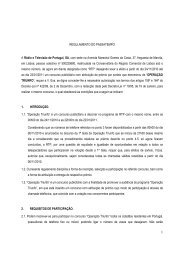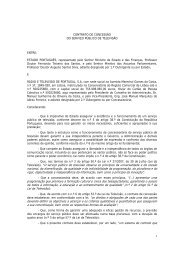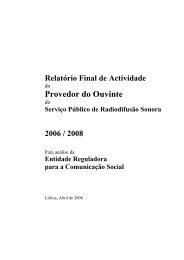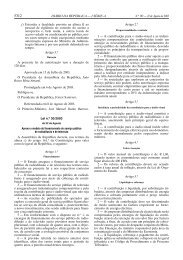6 Bases during the Cold War
6 Bases during the Cold War
6 Bases during the Cold War
Create successful ePaper yourself
Turn your PDF publications into a flip-book with our unique Google optimized e-Paper software.
towards an arms-supply relationship with <strong>the</strong> USSR. Still earlier <strong>the</strong> U.S. apparentlyhad a similar SCF on Zanzibar Island, within Tanzania.Strategic early warning50One of <strong>the</strong> most obviously critical areas of intelligence involving foreign basesis strategic early warning, that is, warning of impending or unfolding nuclearattack. Here, as in so many areas of military endeavor, <strong>the</strong> U.S. was asymmetricallydependent on foreign access, and crucially so. Indeed, it was long <strong>the</strong> case,even before <strong>the</strong> advent of intercontinental missilery, that <strong>the</strong> U.S. relied onradars in Canada and Greenland for warning of approaching bombers at a timewhen such warning could provide several hours of response time. The asymmetrieswere partly because of <strong>the</strong> larger relative size of <strong>the</strong> USSR and partlybecause of <strong>the</strong> location of critical foreign terrain – Canada, Greenland, Iceland –between <strong>the</strong> U.S. and <strong>the</strong> trans-Arctic routes that would be traversed by missilesand bombers across <strong>the</strong> arctic regions between <strong>the</strong> superpowers.Several key U.S. early-warning systems utilized foreign access; ground stationsused to relay data from early-warning satellites; <strong>the</strong> BMEWS radar systemdirected against Soviet ICBMs, <strong>the</strong> several layers of radar pickets used to detectbombers en route to <strong>the</strong> U.S. from <strong>the</strong> Arctic region; and a variety of o<strong>the</strong>rsensors which might be used in collateral or supplementary roles.Regarding early-warning satellites, <strong>the</strong> U.S. relied primarily on what havebecome known as DSP East and DSP West (earlier <strong>the</strong>se were called MIDASsatellites). The former had <strong>the</strong> primary task of watching for ICBM launches, <strong>the</strong>latter for SLBM launches in <strong>the</strong> Atlantic.The Code 647 Defense Support Program satellite – DSP East – sat some23,000 miles above <strong>the</strong> Indian Ocean in geosynchronous orbit, monitoring <strong>the</strong>eastern hemisphere. It contained an infrared telescope equipped with thousandsof tiny lead-sulphide detectors designed to pick up <strong>the</strong> hot exhaust flame producedby large rocket engines <strong>during</strong> <strong>the</strong> boost phase of <strong>the</strong>ir flights. It had fullcoverage of Soviet missile fields from an orbit more or less above <strong>the</strong> equatorand, in <strong>the</strong> case of mass launchings, could tell what kinds of missiles had beenlaunched and from where. Hence, DSP East could also provide valuableinformation about what kind of attack had been launched, that is, <strong>the</strong> likely targetingmix. That would in turn have guided <strong>the</strong> targeting of a U.S. counterforceresponse.The principal and necessary link between DSP East and NORAD was <strong>the</strong>down-link facility at Nurrungar, Australia (<strong>the</strong>re were also control and trackingfunctions at Pine Gap and on Guam) described as a highly vulnerable set ofantennas, transmitters and computational facilities. This “readout station” in turnwould relay data to NORAD, variously by underseas cable, by HF radio links orvia <strong>the</strong> Defense Satellite Communications System, and in turn via a switchingstation in Hawaii. These various alternative communications links between Nurrungarand Buckley AFB in Colorado involved foreign access to New Zealand,Fiji, Norfolk Island and Canada’s British Columbia at Port Alberni. In recent<strong>Bases</strong> <strong>during</strong> <strong>the</strong> <strong>Cold</strong> <strong>War</strong> 125İ 2007 Robert E. Harkavyyears, however, ano<strong>the</strong>r down-link for DSP East (called <strong>the</strong> Simplified ProcessingStation) had been made operational at Kapaun, FDR Germany.A second major U.S. strategic warning system used to monitor ICBMlaunches was BMEWS, which comprised three major radars (located at Clear,Alaska, Thule, Greenland and Fylingdales Moor, U.K.). These radars becameoperational in 1950 and had 4800-km ranges. The BMEWS facility includedfour AN FPS-50 detection radars and an AN/FPS-49 tracking radar – <strong>the</strong>se alsoacted as contributing sensors for <strong>the</strong> SPADATS system. Altoge<strong>the</strong>r, <strong>the</strong>re were12 radars with ranges of 4800 km.Finally, <strong>the</strong> U.S. had long relied – primarily for warning of <strong>the</strong> approach ofbombers – on <strong>the</strong> series of radar picket lines across <strong>the</strong> Arctic known as <strong>the</strong>Distant Early <strong>War</strong>ning (DEW) and Continental Air Defense Integration North(CADIN) Pinetree lines. These had been located across Alaska, Canada andGreenland, with a few additional outposts in Iceland and <strong>the</strong> Faeroe Islands (<strong>the</strong>126 <strong>Bases</strong> <strong>during</strong> <strong>the</strong> <strong>Cold</strong> <strong>War</strong>Table 9 Location of DEW Line and CADIN Pinetree Line radar sites in Canada andGreenland, 1985DEW LinesPage 32Page 33
















